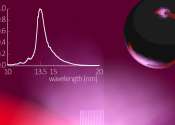World's smallest semiconductor laser heralds new era in optical science
(PhysOrg.com) -- Researchers at the University of California, Berkeley, have reached a new milestone in laser physics by creating the world's smallest semiconductor laser, capable of generating visible light in a space smaller ...








